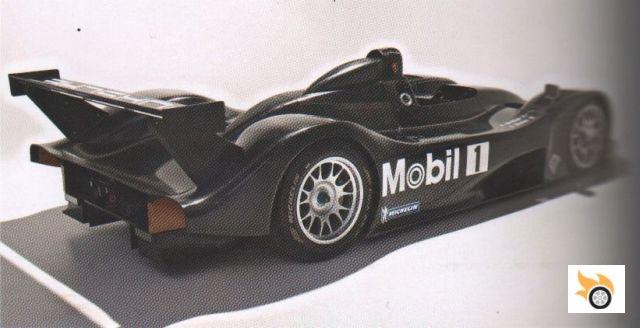I am referring to the different categories that compete at the 24 Hours of Le Mans, with different types of cars.
There are four categories at Le Mans, corresponding to three types of car. The categories are LMP1 (Le Mans Prototype 1), LMP2 (Le Mans Prototype 2), GTE PRO (Gran Turismo Endurance Professional) and GTE AM (Gran Turismo Endurance Amateur). In turn, the maximum category, LMP1, is divided into two subcategories, LMP1-H (Le Mans Prototype 1 hybrid), and the "normal" LMP1 (without hybrid technology).
Let's go with a detailed analysis of each category and subcategory, from the fastest to the slowest.
LMP1-H
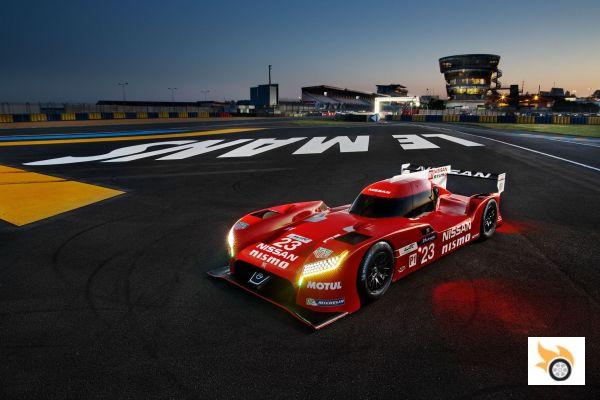
This is the queen category, reserved for "manufacturers". The ACO, the race organizers, understand by "manufacturer" any car manufacturer involved in chassis, engine and team sponsorship. So if a car manufacturer powers an LMP1 team but does not help with the chassis, it would not be a "manufacturer team".
LMP1-H is intended for closed prototypes whose dimensions are limited in height to 1,050 millimeters (remember how tiny Lucas told us a few days ago that these cars were), a maximum length of 4,650 mm, a maximum width of 1,900 mm and a maximum overhang of 1,000 mm at the front and 750 at the rear. The wheelbase and tracks are free.
The minimum weight of the car is 870 kilograms (manufacturers, depending on the design, can create lighter cars, but must mount ballast). The maximum fuel tank size is 68.3 litres for petrol cars and 54.2 litres for diesel cars.
The ACO requires all manufacturers competing at Le Mans with an "official" car to do so with a hybrid propulsion system. In return, the ACO does not set limits on the type of hybrid systems, nor does it set limits on the power, type or displacement of the combustion engine.
What the ACO does control are certain aspects of hybrid implementation. It limits the number of energy generators that can recover energy from the car (either thermal or kinetic) to two, while it does not limit the number of engines in charge of using the recovered energy to propel the car again.
In a future installment we will explain the technical solutions applied by each team, but basically you can choose to have kinetic energy recuperators that capture energy from the braking of the car, or electric generators powered by the energy and heat of the exhaust gases from the engine.
The big key to the whole "invention" of the ACO regarding its open positioning in terms of propulsion for Le Mans cars is in the control of energy consumption. The ACO sets up a cross-table where it indicates how many megajoules of fuel can be burned per lap at Le Mans for each type of car, and allows a number of recovered energy megajoules to be counted for re-application to the car. The table is as follows:
At the top you will see it says ERS Options. Here what is indicated is the amount of energy the car can recover in one lap. The zero is not valid for the LMP1-H category (it is for the "normal" LMP1 category which we will talk about later).
The official teams have to choose in which energy category they want to take part. How much energy they want to recover in each lap and accumulate it in the car to make it available. Depending on that amount of energy, the ACO allows more or less megajoules of fuel energy to be consumed per lap.
But this has a trick. Let me explain. If you look, where it says "petrol energy" and where it says "diesel energy" are indicated amounts in megajoules that can be used in combustion engines for each energy division of the ERS. Logic would make you think that for every 2 megajoules recovered, the amount of fuel to be burned should be 2 megajoules less, right? But it doesn't. Why not? Well, because what the ACO measures is the energy of the fuel being burned, not the energy obtained from it.
As you may well know, and if I don't explain it to you, an internal combustion engine is tremendously inefficient. Less than a third of the energy from the fuel is converted into mechanical energy at the wheels. The rest of the energy is lost in noise, vibration and heat.
If we take a petrol combustion engine's energy efficiency of 25%, for example, which is a more than respectable figure, we will see that the energy available per lap to burn in an 8 MJ class LMP1 is 138 MJ, but of that 138 MJ at the wheels will be in the order of 34.5 MJ, plus the 8 MJ available to the hybrid system. In total, the car will have 42.5 MJ to complete a lap of Le Mans as driving energy.
If we do the same calculation for the 2 MJ category, we will see that 147 MJ of gasoline can be burned, which will be converted into about 36.75 MJ at the wheels, plus the two megajoules of the hybrid system... the result is 38.75 MJ at the wheels to push the car.
Eureka. It turns out that the lower your energy recuperation capacity, the slower your car is, the less energy it can muster for a single lap. The difference in energy between the 8 MJ category and the 2 MJ category for gasoline engines is 16% more for the car in the 8 MJ category. This is important to remember what we told you the other day: Every megajoule of energy recovered is a competitive advantage of about 0.8 seconds in lap time at Le Mans.
The diesels have a similar scaling, but since the thermal efficiency of diesel engines is superior to gasoline engines, so they are allowed to burn less fuel energy per lap, to prevent the diesels from being faster than the gasoline. According to our own mathematics and our data, a diesel LMP1 car is potentially faster than a petrol car under the current ACO rule table.
On the other hand, since the fuel tank size is the same for all ACO energy divisions, the more megajoules you can get from the ERS, the less fuel you burn (by regulatory requirement) so you can lengthen your pit stops.
In short, this regulation puts a lot of emphasis on racing in the biggest energy category you can. Of course this has a downside, in the form of potential reliability problems (high power hybrid cars are always more complicated), and also a downside in weight. And that is that ERS systems are heavier the more energy they are able to store. By having a regulation that works with a fairly tight minimum weight, teams racing with 8 MJ energy storage have more trouble getting close to the minimum weight than teams racing with less energy storage. For example, the Nissan GT-R LM Nismo is said to weigh 880 kilograms, 10 more than the regulatory minimum weight, which makes it pretty clear that it's pretty tricky to get close to the ACO limit with 8 MJ of energy to store. Last year's R18 e-tron, on the other hand, was well below the minimum weight, and played with ballast to get to that minimum figure.
The advantage of being able to play with the ballast is that it also allows you to modify the weight distribution of the car if you want to change it, and usually allows you to reduce the polar moment of inertia of the vehicle with respect to a car that is overweight.
In conclusion, the LMP1-H are small hybrid technological jewels where a great engineering load is accumulated. But the most advantageous thing about them is that they are exposed to a technological freedom that we haven't seen since Group C times. Playing only with fuel consumption and energy storage limitations means that each manufacturer can create cars that are really different from the others and stay within the regulations, which allows us to see four official cars this year with four completely different technological approaches.
LMP1
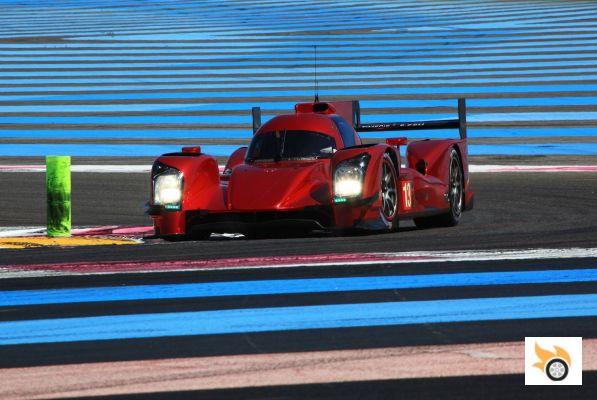
The other part of the premier class, LMP1, is provided by the privateer teams. LMP1 "no hache" is restricted to privateer teams. They cannot use a hybrid system, so their car has to be powered by a conventional combustion engine, limited to a maximum displacement of five and a half litres.
In terms of dimensions and aerodynamic aspects and regulations, the cars are identical to the LMP1-H cars. The ACO allows them to run with less weight (850 kilos), and with more fuel burned per lap (157.2 MJ per lap of gasoline), seeking to match performance with the official LMP1.
The problem is that even so, the privateer LMP1 cars are still clearly slower than the official ones, and play under their own classification and merits, something curious on the other hand, as there are only three "unofficial" LMP1, Colin Kolles' team, and the two Rebellion Racing, which will fight to take the victory of the category and try to catch some crumbs in the overall that leave potential withdrawals of the "manufacturer" cars.
LMP2
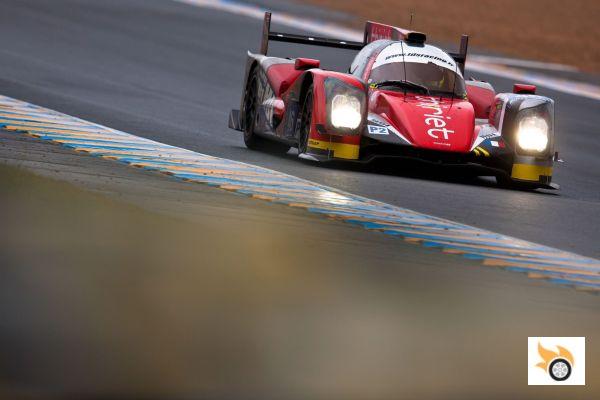
It is no coincidence that the LMP2 Oreca looks a lot like the Rebellion, as the LMP1 and LMP2 chassis are virtually identical in design, and both cars have been developed by the same engineers.
Le Mans Prototype 2 is a category designed to offer private teams, gentleman and rookies the opportunity to get their first taste of Le Mans. It is by far the most competitive category and the hardest to predict.
Why is that? Because the ACO has regulations designed to control costs and performance. To start with, all teams have to use cars whose complete chassis costs less than 450.000€ (cheap for a prototype, believe me). To continue, the engines have to be ACO homologated engines, with "controlled" performance, and derived from mass-produced engines. Hence the Nissan eight-cylinder is the big winner, being an economical, reliable and sensible choice.
The ACO's aim for this category, by their own admission, is to deliver "equally competitive, effective, reliable and economical cars" where it is the hands of the drivers and track engineers and strategists that matter in the end result.
In fact, if an LMP2 chassis proves to be much faster than the rest, the ACO reserves the right to modify it through changes in aerodynamics and weights to match the performance of the other cars in the category.
In terms of design, the chassis of the LMP2 is homologated as the LMP1, offering similar safety features, but using cheaper materials and constructions, in order to reach the price limit required by the ACO (less titanium, less Zylon...).
The cars weigh a minimum of 900 kilos, and can use atmospheric engines of five liters of gasoline, or turbocharged 3.2 liters.
Manufacturers are not allowed to be involved in this category and must be satisfied with being engine suppliers. They cannot be involved in manufacturing or offering chassis to privateer teams, something Porsche did before the change to the current regulations, and which the ACO wants to banish to avoid LMP2 becoming expensive and dominated for promotional purposes by the manufacturers. They want the manufacturers running in the top class.
GTE Pro

Le Mans started out as a race for registered Gran Turismo cars, and the GTE Pro category aims to maintain that connection with the dealers.
It is reserved for Gran Turismo cars homologated under GTE regulations, which are almost identical to FIA GT2. They are street-derived cars, but extensively modified for racing. The level of modifications is so extensive that, to give an example, the current Porsche 911 GT3 RSR uses a double wishbone front suspension in this category, when the standard car's front suspension is a McPherson strut.
The car must weigh 1,245 kilograms, have a 90-litre fuel tank, be less than 4.8 metres long, and have two doors. The ACO limits engine performance through a system of intake flanges based on engine displacement.
Speculation has long been rife about the future of the category, as fewer and fewer manufacturers are interested in creating racing machines as expensive as a GTE/GT2, as the market is currently thin for such cars, which ultimately have little to do with their road-going counterparts in many cases.
One of the ideas that has been gaining momentum is the conversion of the category to FIA GT3 rules, which would introduce an artificial "balance of performance". This would open the door to race with less prepared cars, more economical, whose performance would be artificially modified by changes in aerodynamics, weight and intake flanges to equalize the performance and lap times of all.
But the ACO is not convinced about this artificial performance balance. Neither are we. We like the freedom of the current GTE better. For the time being, we can still enjoy it this year. In any case, let's not fool ourselves, the ACO is already adulterating the competition for years, as it makes a performance balance through changes in weights, intake flanges and aerodynamics in GTE, which has allowed Aston Martin to be in the fight against technologically superior cars.
GTE AM
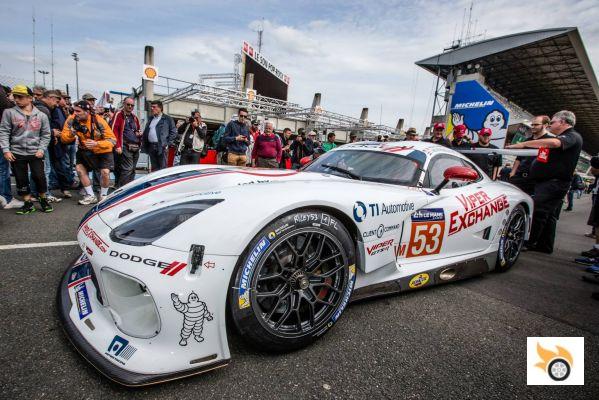
GTE AM is a category designed by and for Gentleman Drivers. The ACO requires teams that want to participate in this category to have two drivers "not as good" as the "Pro" drivers (historical sporting results are taken into account) in the line-up of each car.
The GTE AM teams use the same cars as the GTE Pro teams, but in a previous year's specification. The ACO's idea is that the GTE AM teams use used cars from previous seasons, in order to reduce competition costs and continue to attract a multitude of non-professional drivers who wish and aspire to participate, chequebook in hand, in the 24 Hours of Le Mans.
Curiously, the fact of being able to count on a driver of level within the line-ups of these cars, if paired with non-professional drivers "of decent pace" usually gives great results, with cars that often squeeze those of the top category.
The return of Alfa Romeo: from the 1900 to the Giulia
 LMP1 en las 24 Horas de Le Mans">
LMP1 en las 24 Horas de Le Mans">







